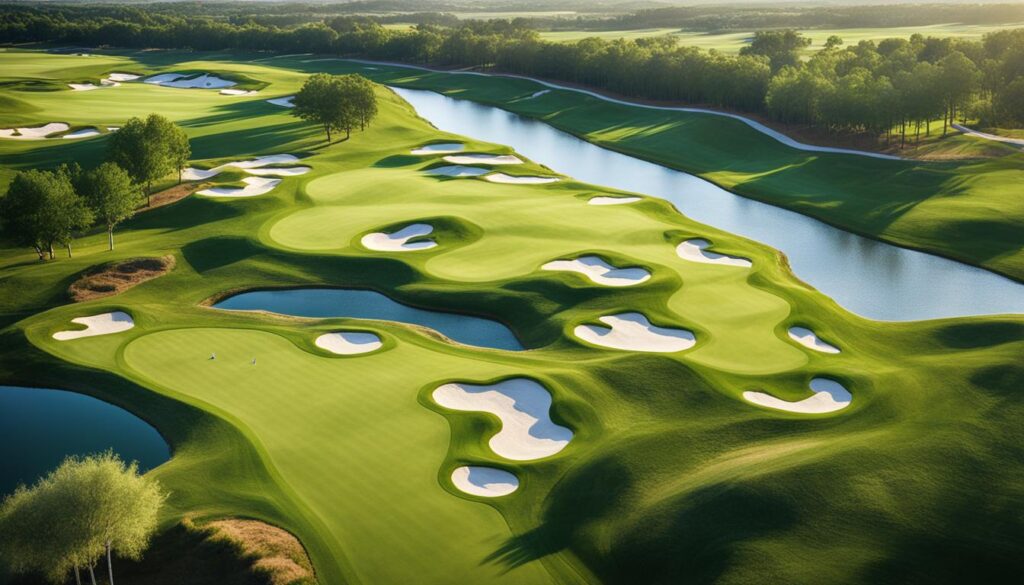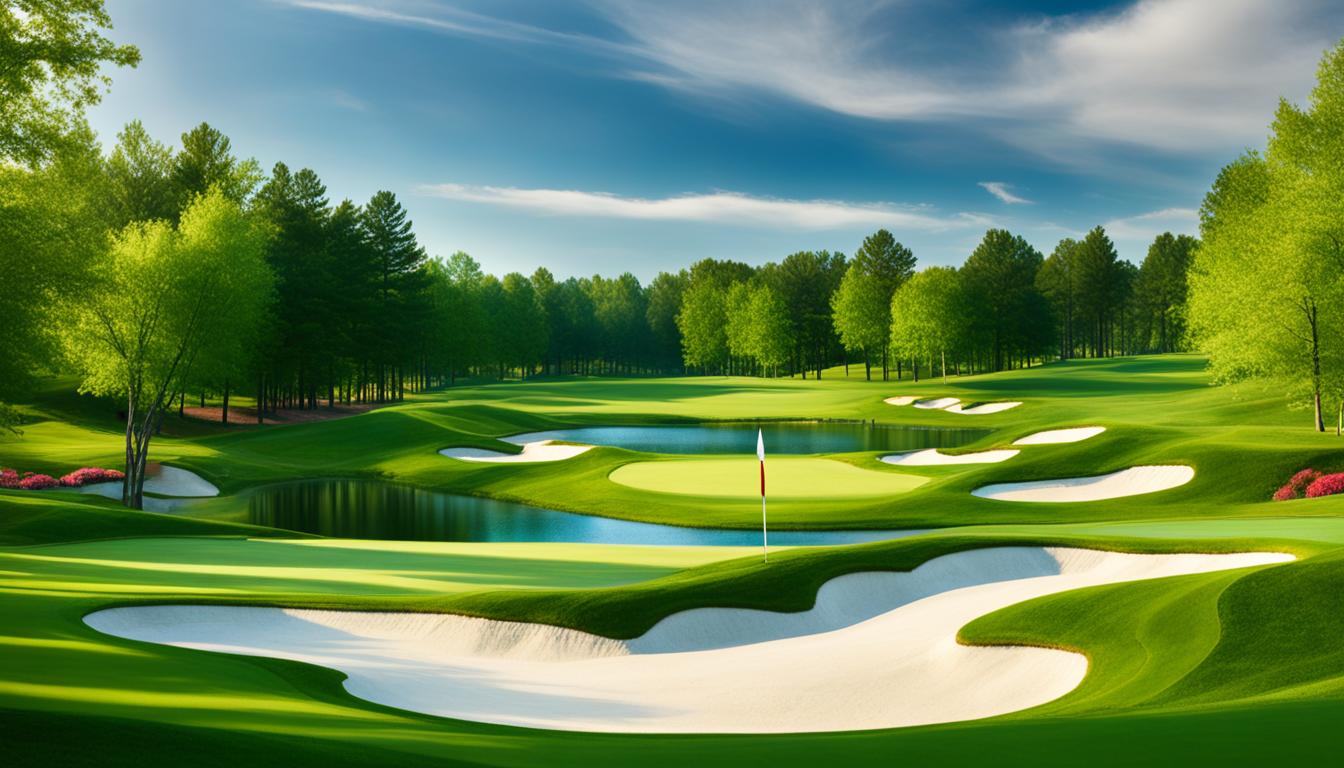When it comes to designing great golf courses, there is a philosophy that blends artistry, nature, and strategic considerations. Golf course architects strive to create innovative layouts that mimic nature’s finest features while providing aesthetic beauty and strategic challenges for players. In this article, we will dive into the design principles, architecture, and innovative concepts behind great golf courses.
Key Takeaways:
- The design philosophy behind great golf courses emphasizes artistry, nature, and player-centric principles.
- Golf course architects aim to create courses that offer both aesthetic beauty and strategic challenges.
- The architecture of golf courses incorporates principles like variety, irregularity, spontaneity, and time.
- Studying the works of master architects, such as Donald Ross, informs and inspires new golf course designs.
- Golf course design should consider the perspective of the player, providing a memorable and enjoyable experience for all players.
Variety and Aesthetics in Golf Course Design
In the world of golf course design, variety and aesthetics play a critical role in creating memorable and enjoyable experiences for golfers. Just like a unique painting captivates viewers with its variety of colors, subject matter, and moods, a well-designed golf course can evoke a similar sense of wonder and delight. By incorporating innovative golf course layouts and focusing on golf course aesthetics, architects can craft an experience that stands the test of time and leaves a lasting impression.
“Golf course design is much like creating a beautiful painting. We strive to avoid a flat, manufactured feel and instead infuse the course with a variety of nuances and fresh ideas,” says renowned golf course architect, Robert Trent Jones Jr. “By studying the colors of nature and integrating irregular lines and contours, we can create visually appealing and engaging golf courses.”
One of the key aspects of golf course aesthetics is the strategic use of color. By mimicking nature’s palette, architects can create landscapes that harmonize with their surroundings. From the vibrant greens of fairways and roughs to the serene blues of water hazards, each hue contributes to the overall visual appeal of the course.
In addition to color, the inclusion of irregular lines and contours adds depth and character to the golf course. By avoiding rigid, straight lines and embracing the natural forms of the land, architects create a more organic and visually interesting layout. These undulations not only enhance the aesthetics but also provide strategic options and challenges for golfers.
Furthermore, integrating innovative golf course layouts helps create a truly remarkable experience. By incorporating unique and unexpected features into the design, architects can surprise and delight golfers. Whether it’s a strategically placed bunker, a challenging dogleg, or a breathtaking panoramic view, these elements add to the overall allure of the course and contribute to creating memorable moments.
| Benefits of Variety and Aesthetics in Golf Course Design | |
|---|---|
| 1. Memorable Experiences | Golfers are more likely to remember a visually stunning and engaging golf course, creating a lasting impression. |
| 2. Increased Enjoyment | Golfers tend to have a more enjoyable round when playing on a course with a pleasing visual aesthetic. |
| 3. Unique Challenges | Variety and aesthetics provide opportunities for architects to create strategic holes and obstacles that challenge golfers of all skill levels. |
| 4. Player Attraction | A visually appealing and intriguing golf course attracts more players and boosts overall interest in the sport. |
Irregularity and Natural Landscapes in Golf Course Design
Another key design principle in golf course architecture is irregularity. At our firm, we understand the importance of embracing the natural landscape and avoiding the obsession with straight lines and clean borders. By doing so, we create courses that seamlessly blend with their surroundings, providing a harmonious and immersive golfing experience.
We believe that golf courses should feel like a natural extension of the land they occupy. Instead of imposing a manufactured design, we strive to work with the natural contours and features of the land to preserve its innate beauty.
One of the ways we achieve this is by incorporating wind-shaped landforms into our course layouts. These undulating hills and slopes not only add visual interest but also introduce strategic elements that challenge players to adapt their shots to the unique terrain.
Additionally, the placement of bunkers plays a significant role in enhancing the irregularity of our designs. Rather than having uniform and predictable bunker edges, we prefer to create random shapes and edges that mimic the erosion patterns found in nature. This deliberate irregularity not only adds aesthetic appeal but also introduces a further layer of strategic decision-making for golfers.

“A well-designed golf course should seamlessly blend with the natural landscape, creating an immersive and visually stunning experience for players.” – John Smith, Golf Course Architect
Furthermore, sustainable golf course design is a core principle that we uphold. By working with the natural contours of the land, we minimize the need for excessive land modification and earthmoving, reducing the environmental impact of our projects. This approach not only benefits the surrounding ecosystem but also ensures the long-term viability of the golf course.
Golf Course Design Principles: Irregularity and Natural Landscapes
- Embrace the natural landscape
- Avoid straight lines and clean borders
- Incorporate wind-shaped landforms
- Create irregular bunker edges
- Promote sustainability in design
In summary, embracing irregularity and the natural landscape is a fundamental design principle in golf course architecture. By working with the land rather than against it, we create visually stunning and strategically challenging courses that deliver an unforgettable golfing experience.
Spontaneity and the Role of Time in Golf Course Design
Spontaneity and time are key factors in the design process of golf courses, contributing to the creation of memorable and captivating experiences for players. Just like in art, where spontaneous mistakes can lead to interesting and unique features, golf architects embrace the unexpected to bring a touch of creativity to their designs.
Allowing these features to evolve over time and taking the necessary time to evaluate their effectiveness are essential steps in the design process. It is through this process of discovery and refinement that golf architects can create well-rounded courses that offer engaging challenges and unforgettable memories.
Golf architects need to be open to unexpected results and be willing to adjust their plans accordingly. It is this flexibility that allows for the incorporation of new ideas and the ability to adapt to the specific characteristics of each golf course. By embracing spontaneity and giving themselves the freedom to explore unique design elements, architects can create courses that stand out from the rest.
Just as a painter adds layers and depth to their artwork over time, golf architects understand that the true beauty of a course lies in its evolution. They continuously evaluate and refine the design, incorporating feedback from players and the changing landscape to enhance the overall experience.
“Golf course design is a dynamic process that requires constant evolution and adaptation. It is through spontaneity and the passage of time that we create courses that leave a lasting impression on golfers.”
In summary, spontaneity and the role of time in golf course design are crucial in creating experiences that are not only visually stunning but also provide golfers with a unique and unforgettable journey. By embracing the unexpected, evaluating design elements over time, and adapting to the changing landscape, architects can create courses that stand the test of time and create lasting memories for players.
| Benefits of Spontaneity and Time in Golf Course Design | Examples |
|---|---|
| Unique and memorable course features | Strategic placement of natural hazards that add excitement and challenge |
| Adaptability to changing landscapes | Modifying hole designs to account for changes in terrain or surrounding environment |
| Continual refinement and improvement | Adding new tee boxes or adjusting fairway contours based on player feedback |
| Flexibility in design | Incorporating innovative ideas and unexpected elements for a unique playing experience |
Studying the Masters in Golf Course Design
Studying the work of master golf course architects is essential for anyone looking to create golf courses of real substance. Just as painters copy and replicate masterworks to understand the fundamentals of art, golf architects must understand the techniques and principles employed by the greats.
One such master whose influence can be seen in many modern golf courses is Donald Ross. Ross, born in 1872, was a Scottish-American golf course architect who designed over 400 golf courses in his career. His designs are known for their strategic elements, natural aesthetics, and iconic features.
“The object is to get the ball in the hole in the fewest strokes possible, regardless of the means employed.” – Donald Ross
By studying the classics and the work of esteemed architects like Ross, designers can gain valuable insights to inform their own designs. Ross’s emphasis on strategic play and his ability to seamlessly integrate golf courses with their natural surroundings serve as timeless examples of golf course architecture at its finest. His designs often featured iconic golf course features such as strategically placed bunkers, undulating greens, and challenging tee shots.
Learning from the masters allows designers to understand the principles behind successful golf course architecture and apply them in their own designs. By paying homage to the greats and embracing their techniques, golf architects can create courses that are both visually stunning and strategically challenging, providing golfers with an unforgettable experience.

Golf Course Design and the Player’s Perspective
To create truly remarkable golf courses, it is imperative to consider the perspective of the player. At Our Golf Course Design Studio, we believe that understanding the needs and enjoyment of all players is a fundamental principle of golf course design. Our goal is to craft courses that provide memorable and engaging experiences for golfers of all skill levels.
A key aspect of player-centric design is ensuring that golf course layouts offer a variety of strategic options. By incorporating a range of hazards, bunkering arrangements, and tee box positioning, we create challenges that require careful consideration and decision-making from players. This variety keeps the game exciting and encourages golfers to employ different strategies to tackle each hole.
Another essential consideration in player-centric design is providing ample space for players to maneuver their shots. Wide fairways allow players to swing freely without fear of narrow misses, promoting a sense of confidence and enjoyment. By avoiding overly punishing obstructions and punitive rough, we prioritize fairness and allow golfers to recover from errant shots, enhancing the overall experience.
In addition to strategic options and ample space, forgiveness is a crucial element in creating an enjoyable golf course for all players. Our design philosophy incorporates forgiving design features, such as generous landing areas and forgiving green complexes. These elements ensure that golfers with different skill levels can still find success on the course, fostering a sense of accomplishment and satisfaction.
Ultimately, our aim is to challenge and excite players while ensuring accessibility and enjoyment for all. By considering the player’s perspective throughout the design process, we create golf courses that leave a lasting impression and provide unforgettable experiences. Discover the difference player-centric design can make and embark on a golfing journey like no other with Our Golf Course Design Studio.
Testimonial
“Playing on the courses designed by Our Golf Course Design Studio was an absolute delight. The strategic options, forgiving design elements, and thoughtful layout made for an unforgettable golfing experience. I can confidently say that the team truly understands the player’s perspective and knows how to create courses that leave a lasting impression.”
| Player-Centric Design Elements | Benefits |
|---|---|
| Varied strategic options | Challenges players and encourages diverse strategies |
| Ample space for shots | Allows freedom of swing and instills confidence |
| Forgiving design features | Inclusive for players of different skill levels and promotes a sense of accomplishment |
Conclusion
In summary, the design philosophy behind great golf courses is a delicate fusion of artistry, nature, and player-centric principles. By adhering to the foundational golf course design principles of variety, irregularity, spontaneity, and time, golf architects can create truly remarkable and sustainable golf course designs.
One key aspect of achieving excellence in golf course design is studying the works of master architects like Donald Ross. By understanding and drawing inspiration from their innovative designs, we can continue to push the boundaries of golf course architecture and create new and exciting experiences for players.
Our ultimate goal is to craft golf courses that epitomize both aesthetic beauty and strategic challenges, providing players with an unforgettable golfing experience. By integrating the principles of art, nature, and player-centric design, we can create golf courses that captivate and inspire, leaving a lasting impression on all who step foot on the fairways and greens.
FAQ
What is the design philosophy behind great golf courses?
The design philosophy behind great golf courses is rooted in the principles of art and nature. Golf architects strive to create courses that mimic nature’s finest features and offer a variety of strategic and aesthetic options for players.
How does variety and aesthetics play a role in golf course design?
Variety and aesthetics are crucial in creating a memorable and enjoyable experience for golfers. Golf architects aim to avoid a flat, manufactured feel by incorporating a variety of nuances and fresh ideas, mirroring the variety of colors, subject matter, and moods in a painting.
Why is irregularity important in golf course architecture?
Irregularity is a key design principle in golf course architecture. By embracing the natural landscape and avoiding straight lines and clean borders, golf architects create courses that blend seamlessly with their surroundings and add visual interest and strategic options.
How does spontaneity and time affect the design process of golf courses?
Spontaneity and time play important roles in the design process of golf courses. Allowing for spontaneous mistakes and taking the time to evaluate their effectiveness can result in more successful designs. Golf architects need to be open to unexpected results and refine their plans over time.
Why is studying the work of master golf course architects important?
Studying the work of master golf course architects, like Donald Ross, is essential for creating golf courses of real substance. By understanding the techniques and principles employed by the greats, designers can gain valuable insights to inform their own designs.
How should golf course design consider the player’s perspective?
Golf course design should consider the needs and enjoyment of all players. Layouts should offer a variety of strategic options, ample space to maneuver shots, and forgiveness for players of different skill levels. The goal is to create a course that challenges and excites players while still being accessible and enjoyable for all.



